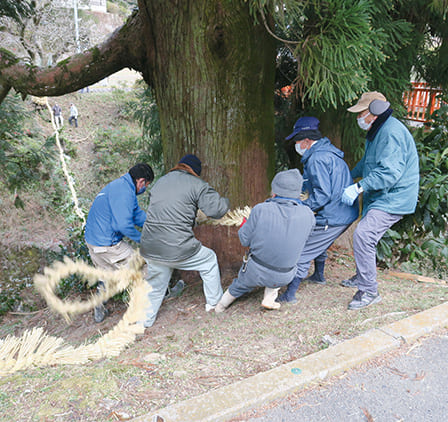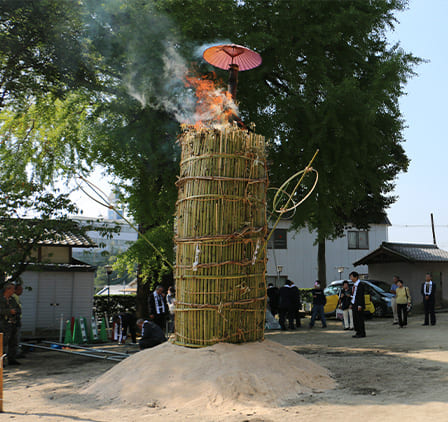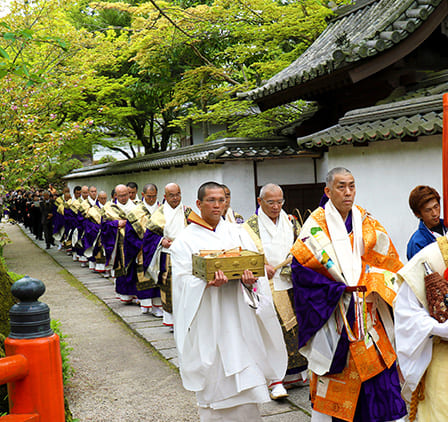
Festivals Interwoven with Daily Life
The enduring connection between temples, shrines, and the local residents is vividly reflected in the traditional festivals that continue to thrive today. Events such as the Sho-Mieku (Kukai Memorial Service) ceremony at Kongoji Temple, the Taimatsu Tate Fire Festival at Nagano Jinja Shrine, and the Kanjo Nawa-kake (rope-hanging) Festival at Hachiman Jinja Shrine are brought to life through the collaborative efforts of local communities and these sacred sites. These festivals are a testament to how residents and religious institutions work hand in hand to preserve and pass down these time-honored traditions.

Kanjo Nawa-kake (rope-hanging) Festival at Hachiman Jinja Shrine
Each year, around January 6, Hachiman Jinja Shrine hosts a traditional festival called Kanjo Nawa-kake.
This date commemorates January 6, 1039, when the shrine's deity was said to have been enshrined from Iwashimizu Hachimangu Shrine (Kyoto), an event that inspired the annual festival.
On the morning of the festival, local residents gather to weave a sacred rope called Kanjo Nawa using rice straw. The rope is then stretched across the river, connecting a persimmon tree in front of the shrine to a Sugi tree known as Kanjyosugi on the opposite bank. The rope, which varies in size each year, typically measures about 60 meters in length and weighs around 100 kilograms.
The timing of the rope's breakage is believed to forecast the year's agricultural yield.
Location: Hachiman Jinja Shrine
Open to visitors

Taimatsu Tate Fire Festival at Nagano Jinja Shrine
Each year, on October 11, Nagano Jinja Shrine hosts the Taimatsu Tate Fire Festival, a vibrant traditional festival featuring towering torches.
The name Taimatsu refers to outdoor torches made by lighting wooden pieces, and Tate means “to stand.” The festival is known as Taimatsu Tate for its centerpiece: a towering torch approximately 5 meters tall and 4 to 5 meters in circumference. The torch is crafted with a pine log as its core, encased in leafy branches. This structure is then encased in a bamboo lattice to form the massive torch. Atop the torch, a traditional Japanese umbrella is placed and opened to protect it from rain. Lighting is performed from above, with participants climbing a ladder to ignite the torch.
The festival's origins trace back to the initial enshrinement of the deity at Nagano Jinja Shrine.
According to tradition, the procession escorting the deity to the shrine was delayed until nightfall. In an era without streetlights, local residents lit torches at Nagano Jinja Shrine to guide the way and prevent the procession from losing its path. The successful arrival of the deity, illuminated by these torches, inspired this annual celebration.
Location: Nagano Jinja Shrine
Open to visitors

Sho-Mieku (Kukai Memorial Service)
Sho-Mieku is a memorial service held annually on April 21, corresponding to the 21st day of the 3rd month in the lunar calendar, which marks the anniversary of Kobo Daishi Kukai's passing.
The term Mieku refers to a memorial service in which a portrait of the deceased is displayed and honored. In Shingon Buddhism, this service is particularly significant as it involves hanging a portrait of Kobo Daishi Kukai, the founder of Shingon sect, and performing rituals in his memory.
At Kongoji Temple, Sho-Mieku is a grand ceremony, and preparations begin about a week in advance in collaboration with local residents. Offerings to Kobo Daishi Kukai's portrait include sweet potatoes, soybeans, broccoli, eggplants, fruits, and colorful small rice cakes. Local residents thoughtfully arrange these offerings on trays. These offerings are collectively known as Hyakumi no Onjiki (a hundred flavors of food and drink), symbolizing an abundance of delectable items. While the term Hyakumi (hundred flavors) does not refer to an exact count, it conveys the idea of a large and diverse array of offerings.
Location: Kongoji Temple
Open to visitors
Copyright©Kawachinagano City. All Rights Reserved

